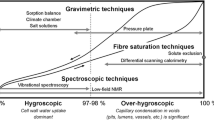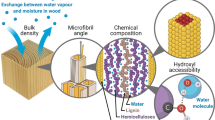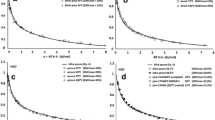Abstract
The fiber saturation point (FSP) is an important concept in wood–moisture relations that differentiates between the states of water in wood and has been discussed in the literature for over 100 years. Despite its importance and extensive study, the exact theoretical definition of the FSP and the operational definition (the correct way to measure the FSP) are still debated because different methods give a wide range of values. In this paper, a theoretical definition of the FSP is presented based on solution thermodynamics that treats the FSP as a phase boundary. This thermodynamic interpretation allows FSP to be calculated from the chemical potentials of bound and free water as a function of moisture content, assuming that they are both known. Treating FSP as a phase boundary naturally lends itself to the construction of a phase diagram of water in wood. A preliminary phase diagram is constructed with previously published data, and the phase diagram is extended to a state diagram by adding data on the glass transition temperatures of the wood components. The thermodynamic interpretation and resulting state diagram represent a potential framework for understanding how wood modification may affect wood–moisture relations.




Similar content being viewed by others
References
Almeida G, Gagne S, Hernández R (2007) A NMR study of water distribution in hardwoods at several equilibrium moisture contents. Wood Sci Technol 41:293–307
Anderson RB (1946) Modifications of the Brunauer, Emmett, and Teller Equation. J Am Chem Soc 68:686–691
Araujo C, MacKay A, Hailey J, Whittall K, Le H (1992) Proton magnetic resonance techniques for characterization of water in wood: application to white spruce. Wood Sci Technol 26:101–113
Babiak M, Kudela J (1995) A contribution to the definition of the fiber saturation point. Wood Sci Technol 29:217–226
Berry SL, Roderick ML (2005) Plant–water relations and the fibre saturation point. New Phytol 168:25–37
Choong ET, Tesoro FO (1989) Relationship of capillary pressure and water saturation in wood. Wood Sci Technol 23:139–150
Cousins W (1976) Elastic modulus of lignin as related to moisture content. Wood Sci Technol 10:9–17
Cousins W (1978) Young’s modulus of hemicellulose as related to moisture content. Wood Sci Technol 12:161–167
Dent RW (1977) A multilayer theory for gas sorption. Part I. Sorption of a single gas. Text Res J 47(2):145–152
Deodhar S, Luner P (1980) Measurement of bound (nonfreezing) water by differential scanning calorimetry. In: ACS symposium series. American Chemical Society, Washington DC, pp 273–286
Derome D et al (2013) The role of water in the behavior of wood. J Building Phys 36:398–421
Engelund ET, Thygesen LG, Hoffmeyer P (2010) Water sorption in wood and modified wood at high values of relative humidity. Part 2: Appendix. Theoretical assessment of the amount of capillary water in wood microvoids. Holzforschung 64:325–330
Engelund E, Thygesen L, Svensson S, Hill CS (2013) A critical discussion of the physics of wood–water interactions. Wood Sci Technol 47(1):141–161
Feist WC, Tarkow H (1967) A new procedure for measuring fiber saturation points. For Prod J 17:65–68
Flournoy DS, Kirk TK, Highley T (1991) Wood decay by brown-rot fungi: changes in pore structure and cell wall volume. Holzforsch Int J Biol Chem Phys Technol Wood 45:383–388
Flournoy DS, Paul JA, Kirk TK, Highley T (1993) Changes in the size and volume of pores in sweetgum wood during simultaneous rot by Phanerochaete chrysosporium burds. Holzforsch Int J Biol Chem Phys Technol Wood 47:297–301
Glass SV, Zelinka SL (2010) Moisture relations and physical properties of wood. In: Ross RJ (ed) Wood handbook. Wood as an engineering material. US Department of Agriculture, Forest Service, Forest Products Laboratory, Madison
Glass SV, Zelinka SL, Johnson JA (2014) Investigation of historic equilibrium moisture content data from the Forest Products Laboratory. Forest Service, Forest Products Laboratory, General Technical Report, FPL-GTR-229, Madison
Gliguem H et al (2009) Water behaviour in processed cheese spreads. J Therm Anal Calorim 98:73–82
Griffin D (1977) Water potential and wood-decay fungi. Annu Rev Phytopathol 15:319–329
Hailwood AJ, Horrobin S (1946) Absorption of water by polymers: analysis in terms of a simple model. Trans Faraday Soc 42:B084-B092-B084-B092
Hatakeyama H, Hatakeyama T (1998) Interaction between water and hydrophilic polymers. Themochimica Acta 308:3–22
Hernández R, Cáceres C (2010) Magnetic resonance microimaging of liquid water distribution in sugar maple wood below fiber saturation point. Wood Fiber Sci 42:259–272
Hill CAS (2008) The reduction in the fibre saturation point of wood due to chemical modification using anhydride reagents: a reappraisal. Holzforschung 62:423–428
Hill CA, Forster S, Farahani M, Hale M, Ormondroyd G, Williams G (2005) An investigation of cell wall micropore blocking as a possible mechanism for the decay resistance of anhydride modified wood. Int Biodeterior Biodegradation 55:69–76
Hoffmeyer P, Engelund ET, Thygesen LG (2011) Equilibrium moisture content (EMC) in Norway spruce during the first and second desorptions. Holzforschung 65:875–882
Jakes JE, Plaza N, Stone DS, Hunt CG, Glass SV, Zelinka SL (2013) Mechanism of transport through wood cell wall polymers. J For Prod Ind 2:10–13
James WL (1963) Electric moisture meters for wood. US Forest Service Research Note FPL-08. US Forest Service Forest Products Laboratory, Madison
James WL (1988) Electric moisture meters for wood. Forest Products Laboratory General Technical Report FPL-GTR-6. US Forest Service Forest Products Laboratory, Madison
Kärenlampi PP, Tynjälä P, Ström P (2005) Phase transformations of wood cell water. J Wood Sci 51:118–123
Lamason C, Macmillan B, Balcom B, Leblon B, Pirouz Z (2015) Water content measurement in black spruce and aspen sapwood with benchtop and portable magnetic resonance devices. Wood Mat Sci Eng 10:86–93
Landry MR (2005) Thermoporometry by differential scanning calorimetry: experimental considerations and applications. Thermochim Acta 433:27–50
Le Maguer M (1985) Solution thermodynamics and the starch-water system. In: Simatos D, Multon JL (eds) Properties of water in foods in relation to quality and stability. NATO ASI series. Series E. Applied Sciences; No. 90. Martinus Nijhoff Publishers in cooperation with NATO Scientific Affairs Division, Dordrecht/Boston/Lancaster
Menon R, MacKay A, Hailey J, Bloom M, Burgess A, Swanson J (1987) An NMR determination of the physiological water distribution in wood during drying. J Appl Polym Sci 33:1141–1155
Miki T, Sugimoto H, Kojiro K, Furuta Y, Kanayama K (2012) Thermal behaviors and transitions of wood detected by temperature-modulated differential scanning calorimetry. J Wood Sci 58:300–308
Nakamura K, Hatakeyama T, Hatakeyama H (1981) Studies on bound water of cellulose by differential scanning calorimetry. Text Res J 51:607–613
Olsson AM, Salmen L (2004a) The softening behavior of hemicelluloses related to moisture. ACS Publications, Washington DC, pp 184–197
Olsson AM, Salmen L (2004b) The association of water to cellulose and hemicellulose in paper examined by FTIR spectroscopy. Carbohydr Res 339:813–818
Passarini L, Malveau C, Hernandez RE (2014) Water state study of wood structure of four hardwoods below fiber saturation point with nuclear magnetic resonance. Wood Fiber Sci 46:480–488
Passarini L, Malveau C, Hernández RE (2015) Distribution of the equilibrium moisture content in four hardwoods below fiber saturation point with magnetic resonance microimaging. Wood Sci Technol 49(6):1–18
Repellin V, Guyonnet R (2005) Evaluation of heat-treated wood swelling by differential scanning calorimetry in relation to chemical composition. Holzforschung 59:28–34
Roos Y, Karel M (1991a) Amorphous state and delayed ice formation in sucrose solutions. Int J Food Sci Technol 26:553–566
Roos Y, Karel M (1991b) Applying state diagrams to food processing development. Food Technol 45(12):66, 68–71, 107
Salmén L, Olsson A-M (1998) Interaction between hemicelluloses, lignin and cellulose: structure-property relationships. J Pulp Pap Sci 24:99–103
Siau JF (1995) Wood: influence of moisture on physical properties. Department of Wood Science and Forest Products, Virginia Polytechnic Institute and State University Blacksburg, Virginia
Simpson W (1980) Sorption theories applied to wood. Wood Fiber Sci 12:183–195
Simpson LA, Barton AFM (1991) Determination of the fibre saturation point in whole wood using differential scanning calorimetry. Wood Sci Technol 25:301–308
Skaar C (1988) Wood–water relations. Springer, New York
Spalt H (1958) The fundamentals of water vapor sorption by wood. For Prod J 8:288–295
Stamm AJ (1929) The fiber-saturation point of wood as obtained from electrical conductivity measurements. Ind Eng Chem Anal Ed 1:94–97
Stamm AJ (1935) Shrinking and swelling of wood. Ind Eng Chem 27:401–406. doi:10.1021/ie50304a011
Stamm AJ (1971) Review of nine methods for determining the fiber saturation points of wood and wood products. Wood Sci 4:114–128
Stone JE, Scallan AM (1967) The effect of component removal upon the porous structure of the cell wall of wood. II. Swelling in water and the fiber saturation point. Tappi 50:496–501
Telkki VV (2012) Wood characterization by NMR and MRI of fluids. eMagRes 1(1). doi:10.1002/9780470034590.emrstm1298
Telkki V-V, Yliniemi M, Jokisaari J (2013) Moisture in softwoods: fiber saturation point, hydroxyl site content, and the amount of micropores as determined from NMR relaxation time distributions. Holzforschung 67:291–300
Thygesen L, Elder T (2008) Moisture in untreated, acetylated, and furfurylated norway spruce studied during drying using time domain NMR1. Wood Fiber Sci 40:309–320
Thygesen L, Elder T (2009) Moisture in untreated, acetylated, and furfurylated norway spruce monitored during drying below fiber saturation using time domain NMR. Wood Fiber Sci 41:194–200
Thygesen LG, Tang Engelund E, Hoffmeyer P (2010) Water sorption in wood and modified wood at high values of relative humidity. Part I: results for untreated, acetylated, and furfurylated Norway spruce. Holzforschung 64:315–323
Tiemann HD (1906) Effect of moisture upon the strength and stiffness of wood. US Department of Agriculture. Forest Service—Bulletin 70. Government Printing Office, Washington DC
Trenard Y (1980) Comparaison et Interpretation de Courbes Obtenues par Porosimétrie au Mercure sur Diverses Essences de Bois. (Comparison and interpretation of Mercury Porosimeter curves obtained on some wood species). Holzforschung 34:139–146 (In French)
Vuataz G (2002) The phase diagram of milk: a new tool for optimizing the drying process. Lait 82:485–500
Wangaard FF, Granados LA (1967) The effect of extractives on water-vapor sorption by wood. Wood Sci Technol 1:253–277
Weise U, Maloney T, Paulapuro H (1996) Quantification of water in different states of interaction with wood pulp fibres. Cellulose 3:189–202
Zauer M, Kretzschmar J, Großmann L, Pfriem A, Wagenführ A (2014) Analysis of the pore-size distribution and fiber saturation point of native and thermally modified wood using differential scanning calorimetry. Wood Sci Technol 48:177–193
Zelinka SL, Glass SV (2010) Water vapor sorption isotherms for southern pine treated with several waterborne preservatives. ASTM J Test Eval 38:80–88
Zelinka SL, Lambrecht MJ, Glass SV, Wiedenhoeft AC, Yelle DJ (2012) Examination of water phase transitions in Loblolly pine and cell wall components by differential scanning calorimetry. Thermochim Acta 533:39–45
Zelinka SL, Glass SV, Boardman CR, Derome D (2014) Moisture storage and transport properties of preservative treated and untreated southern pine wood. Wood Mater Sci Eng. doi:10.1080/17480272.2014.973443
Zhang J, Peralta PN (1999) Moisture content-water potential characteristic curves for red oak and loblolly pine. Wood Fiber Sci 31:360–369
Author information
Authors and Affiliations
Corresponding author
Rights and permissions
About this article
Cite this article
Zelinka, S.L., Glass, S.V., Jakes, J.E. et al. A solution thermodynamics definition of the fiber saturation point and the derivation of a wood–water phase (state) diagram. Wood Sci Technol 50, 443–462 (2016). https://doi.org/10.1007/s00226-015-0788-7
Received:
Published:
Issue Date:
DOI: https://doi.org/10.1007/s00226-015-0788-7




